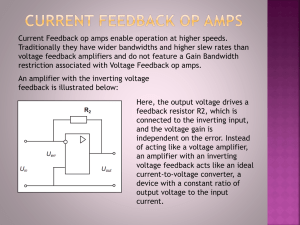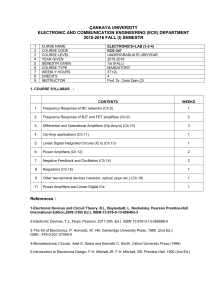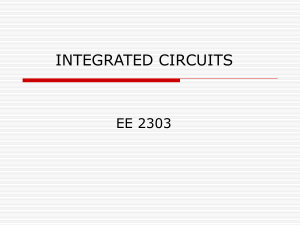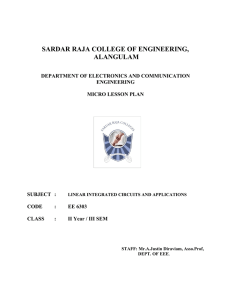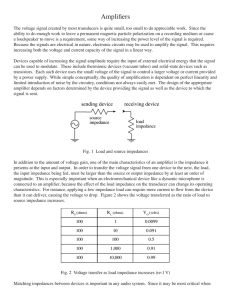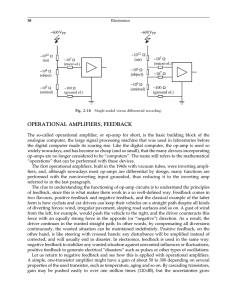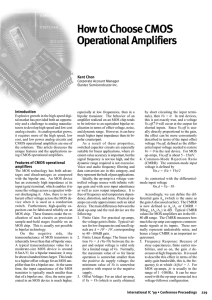Electronic Troubleshooting
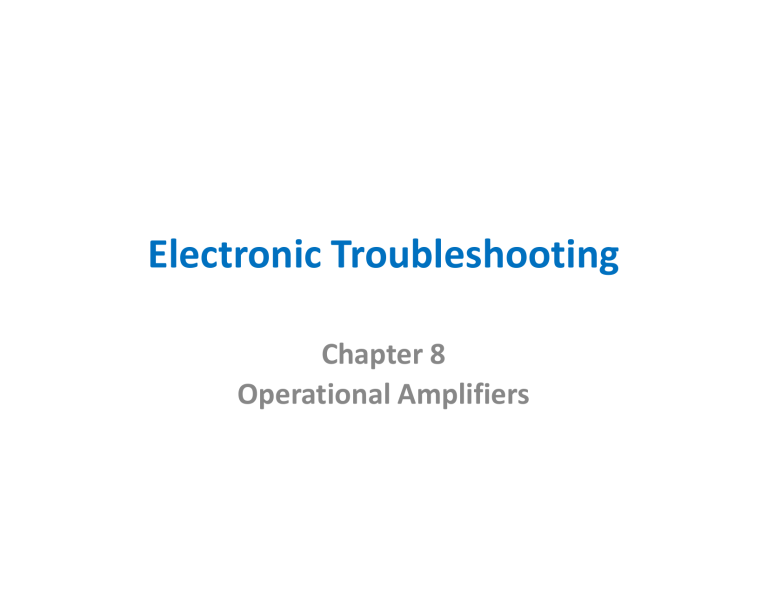
Electronic Troubleshooting
Chapter 8
Operational Amplifiers
Operation Amplifiers
•
Overview
•
Original OP-Amps
Picture from
Wikipedia, see the terms of use on their
•
1940/50’s Tube circuits
•
Discrete component semi-conductor site.
circuits followed
• •
I the first monolithic ICs started appearing in the
1960s
•
The first was in 1963
•
The 741 was released in 1968
•
Packaging
•
Cans
•
DIPs
•
Surface mount
Operation Amplifiers
•
Overview
•
Characteristics
•
Multistage amplifier
•
Coupling Cap
•
Simplified drawing on the top
•
Complementary
Symmetry output
»
Low output impedance
•
Some have FETs on the input
•
Bottom - simplified drawing of LF351
»
741 replacement
Op Amp Basic configuration
•
Open Loop
•
Gain
•
Ideal Gain = infinity
•
Actual = 200k into millions
•
Input Impedance
•
Ideal = infinity
•
Real 100’s of mega ohms
•
Output impedance
•
Ideal = zero
•
Actual ranges to less than 1 ohm
Inverting Amplifier
Critical to understanding operation with feedback
See formulas on the bottom of page 192 and example on 193
Noninverting Amplifier
See formulas on the middle of page 193 and example on 194
Voltage Follower
Amplify AC Signals
Open Loop Voltage Gain vs Freq
741
Finding Upper Cut-off Frequency
Compensate Op Amp
Some very old OP-Amp ICs require external components to prevent high freq oscillations, such as Fairchild’s 709
Data Sheet: http://www.datasheetcatalog.com/datasheets_pdf/L/M/7/0/LM709.shtml
Voltage Follower in AC Circuit
Differential Amplifiers
•
Characteristics
•
Uses ICs instead of discrete components
•
Gain is based R
F and R
1
•
RA and RB also factor into the operation
• •
Use 10 and 100K and walk through
Differential Amplifiers
•
Characteristics
•
Only the difference between signals should be amplified
•
How well this is accomplished in an actual Op-Amp is measured by the Common Mode Rejection Ratio - CMRR
•
Ideally – infinite
• •
Actual is listed in the manufacturers specification sheet
•
Common Mode Gain
A cm
V cmo
V cm where
V cmo
V cm
CommonMode OutputVolt age
CommonMode InputVolta ge
•
Example Problem 8-5 on page 198
Integrator
Level Detector
•
Characteristics
•
As shown the circuit id a zero crossing signal
•
Swap the inputs and its an inverting zero crossing detector
•
Detecting other levels besides zero volts
•
Back to original drawing: add a DC voltage to the inverting input
•
You now have a level detector for that voltage
•
Swap the inputs and you have an inverting detector
LM339 Comparator
Comparator Squaring Circuit
Lo-Battery Indicator
Op-Amp is configured as a 1.5V
level detector
Locating Faults
•
IC failures
•
Almost always from
•
Handling
•
Misuse
• •
Typical misuse/Handling problems
•
Power supply voltages that are too high – Check datasheets
•
Power supply connections are reversed
•
Simple protection is possible
»
Use some diodes
Locating Faults
•
IC failures
•
Typical misuse/Handling problems
•
Too large of input voltages
•
If max input is below 0.7V
»
Use diodes
»
Else use zener diodes
Locating Faults
•
IC failures
•
Typical misuse/Handling problems
•
Output shorted
•
Small resister sized to prevent the max output current from being exceeded
See page 206
See page
206 for discussion
Zero Problems
Other problems


